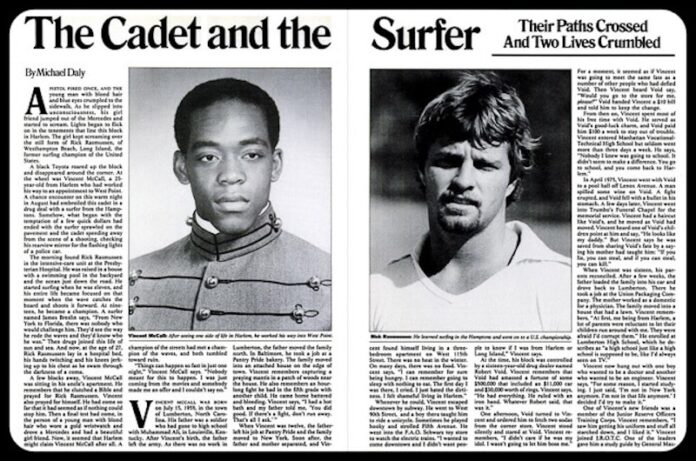
Rick Rasmussen, Bunker Spreckels, Miki Dora etc.
Had the late Rick Rasmussen been 5′ 5″ and weak-chinned with a Stanley Tucci hairline, he’d be little more than a tragic surf-world footnote.
But that very much was not the case.
Rick charged out of Westhampton, NY, like a forgotten Marvel Universe character, like Long Island Thor, chiseled and grinning, charisma levels set to 11, blond hair waving off his teenaged shoulders as he won the 1974 US Championships at Cape Hatteras, and still waving a few months later while emerging from the crypt-end of what was probably the deepest and heaviest wave of the year at Pipeline.
“The lip was thicker than I was tall,” Rasmussen told Surfing magazine, parting ways with modesty as easily as he’d parted ways with high school during sophomore year. “I didn’t know what was gonna happen, then the spray shot me out of the end, and there was Gerry Lopez, paddling out, and his eyes were bugged!”
Those were the twin peaks of Rick Rasmussen’s surfing career. Six years later, in the summer of 1982, he was gunned down at close range during a botched 3:00 AM cocaine deal in northwest Harlem, one week before he was to be sentenced for selling heroin to an undercover policeman, and 10 months after he began working as a DEA informant.
Rasmussen had never quite made the jump to pro surfing—in 1977, the only year he put in a real effort, he finished the WCT season at #47. He meanwhile didn’t have the patience or business talent to scale up his popular but more or less backyard Clean and Natural Surfboards label.
So he imported and sold drugs instead, and used as well, and while it’s not clear exactly when he started down that road—1978 is a good guess—by 1980 he was all in, dressing the part, Rolex and Mercedes, flashy and speedy one day, sloppy and nodding off the next, not much in control either way and very much a danger to himself and those around him.
“He was the sort of guy you didn’t want to know,” pro surfer and writer Derek Hynd later said, “and didn’t want to meet.”
Semi-notorious filmmaker and quote-machine Mike Oblowitz, a man addicted to these kinds of surfers the way Rasmussen was addicted to China White, was even blunter: “[Rick] was a fucking raging heroin addict drug dealer who got shot in the drug deal gone wrong.” (Oblowitz, it should be noted, never met Rick in person and insists that we @ him on Instagram as “shakespeare of surfing,” so let’s add a rock-sized grain of salt to that one.)
Tragic, like I said up top, any way you want to frame it.
Rasmussen came to my attention this week because I hear that there’s an outside chance that Emmy-winning producer Paul Taublieb (Hawaiian: The Legend of Eddie Aikau) will make a documentary based on “The Cadet and the Surfer,” a 1981 New York Magazine article by Pulitzer Prize finalist Michael Daley.
This news fanned the embers of an argument I’ve been having with myself for 20 or so years, and always starts with some iteration of: Why do we continue building the highest pedestals to the biggest fuck-ups?
Rasmussen, Bunker Spreckels, Miki Dora, etc. These days, yes, we are more likely to point out the mess these surfers created, their terminal flaws, the bad choices made, the wreckage and harm.
But there never seems to be a character deformity big enough, or a fallout blast-zone wide enough, that we can’t get past it so that we may again view the person in question as an outlaw hero.
Surfer’s Journal ran an eight-spread profile on Rasmussen in 2017, for example, and I’m looking at a full-page close-up of him in what might be described as Tony Montana casual mode, with gold necklace and shades, feathered coif and disdainful middle-distance stare.
Knowing what’s coming for Rasmussen a year or so down the road—even if we don’t know what is coming, actually—it strikes me as a portrait of self-betrayal.
Surfer’s Journal doesn’t see it that way. The caption reads: “Credit Suisse medallion, tortoise-shell Carrera shades, Björn Borg signature model Fila shirt—this is what a baller looked like, circa 1980.”
I’ve read that a few times, hoping to catch an ironic glint, a wink, but nope, nothing, and it breaks me a little to think that even the adults among us, the upscale surf magazine readers, are getting a rearview charisma hit from this doomed downbound New York surfer-turned-courier.
Then the argument flips.
Because I understand completely how a limited but well-aimed and presented version of a super-gifted person can hit us in a certain way, at a certain time—when we’re kids, basically—and change us forever. Sam Hawk high-lining a Second Reef bomb on Huge Monday. Miki Dora knocking Valley kooks down at Malibu like bowling pins, then getting paid by SURFER to pen-whip the surfing establishment.
Rick Rasmussen winning not just the US Men’s title at Hatteras in 1974, but the Kneeboard division as well, for kicks, for added flex, because on that day, at that place, Raz was totally unstoppable.
As a kid, what more did I want from these surfers? I was in a trance. Surfing was church; I was the solemn grade-school acolyte slow-marching toward the altar, swinging the incense ball. I ate the wafer of Hawk, and Dora, and Raz, and gave thanks.
That means a lot.
My first take on those surfers can be amended, adjusted, self-contravened, but not erased. Fuck-ups they may be, but they are my fuck-ups—my surfing relatives. Part of me will always appreciate what those surfers, and many others like them, bestowed upon me. I was never going to missile-launch out of a Pipeline tube and make Lopez go bug-eyed, but my blond hair was just as long and Viking-perfect as Rick’s.
Anyway, I go round and round like that, which bothers me cause I never quite settle. We want things to be simpler then they are. I want to be more like Rasmussen’s friend and surfing partner Joe Albers, mentioned briefly in the Surfer’s Journal article, who more or less shrugged when asked about Rick’s legacy: “He got a lot of people into surfing. He also got a lot of people into drugs.”
(Editor’s note: Yeah, this is the fine work of ol Matty Warshaw, keeper of the surf culture flame over at the Encylopedia of Surfing. Warshaw delivers these sexy-as-anything, tough guy prose hit-outs every Sunday afternoon and if you want ’em, and if you want to access the keys to his entire archive, toss a few peanuts his way. Five bucks a month.)





